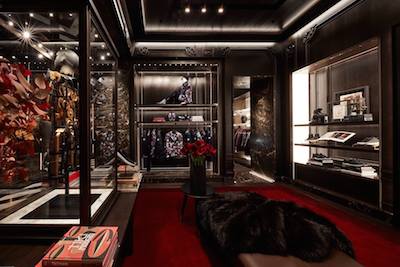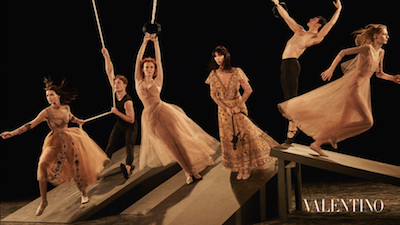After double-digit growth in 2015, the luxury fashion industry is expected to see stability rather than increases in its 2016 financial results, according to a new report by Mediobanca.
In the half of 2016, Italian fashion brands had mixed financial outcomes, with Moncler’s revenue growing close to 17 percent and Prada’s declining 14.8 percent. Despite a challenging market in 2016, the Italian fashion industry can look to bright spots such as shopping tourism and online retail in the year ahead.
"Based on the main trends of the worldwide industry, it is wise to expect a steady 2017 for Italian fashion, more or less on the same levels as of 2015 and 2016," said Gabriele Barbaresco, director of Area Studi Mediobanca.
"The most moving factor is the international geopolitical safety that is likely to impact onto the willingness of people to travel for tourism," he said. "International touristic presence in Italy is currently growing due to the political turmoil in many Mediterranean touristic destinations, especially North Africa.
"Tax free shopping in airports and city shops is one of the main drivers of the Italian fashion industry, as luxury goods are heavily taxed in many ‘new rich’ countries, for example China and others. Chinese, Russian and US people are among the most frequent buyers of Italian fashion.
"Another important channel to boost further is online shopping, currently covering some 10 percent of the total turnover. This channel avoids physical moving and can offset at some extent possible reductions in tourism or freedom of traveling."
Mediobanca’s report looks at 15 Italian fashion companies: Armani, Benetton, Calzedonia, Dolce & Gabbana, Geox, Luxottica, Max Mara, Moncler, OTB Group, Prada, Safilo, Salvatore Ferragamo, Tod’s, Valentino and Zegna.
Steady ahead
The personal luxury goods business in 2015 was valued at 251 billion euro, or about $265.5 million at current exchange. The 12 percent growth in the market was driven largely by currency fluctuations, as the increase was merely 1 percent when measured in constant exchange.
One example of the effect of currency fluctuations was the Americas, which in 2015 surpassed Europe as the largest personal luxury goods market thanks to a strong dollar. Without the difference of the euro to the dollar, this region’s 18 percent growth over 2014 would instead have been flat.
In comparison, 2016 is expected to see a 1 percent decrease when measured in current rates, with steady results when taking currency shifts out of the equation, with total sales of 249 billion euro, or about $263.4 billion at current rates.
In 2015, tourist spending offset declining expenditures by locals in Europe. Chinese consumers were the main driver of tax-free shopping, representing 36 percent of Europe’s total tourist spending on luxury goods.

DFS' T Fondaco dei Tedeschi in Venice
The growth in spending by Chinese tourists also made up for declining sales from Russians due to the ruble’s collapse. Russian consumers are still the second largest nationality spending in Europe, followed by Americans.
In Italy, these same trends appear. Within the country, Milan sees about a third of tourist sales, with Rome in second place.
European duty-free sales are concentrated in France, Great Britain, Italy and Germany. The shopping tourism market in Europe, valued at 50 billion euro last year, saw a decline of 12 percent in the first nine months of 2016, but Mediobanca projects a recovery between 2 to 4 percent in 2017.
While only about 7 percent of luxury sales currently come through online channels, this part of the market has the strongest projected growth. In 2016, digital sales are expected to rise 26 percent.
However, despite online’s potential, more than half of sales still come from traditional retail stores. The report notes the continued benefit of having direct-operated stores that goes beyond sales, pointing to the possibilities for branding that come from having retail outposts in key locations.

Moncler recently opened its first U.S. flagship
With consumers slowing their purchases of hard luxury in favor of experiences, BCG advised a revamped bricks-and-mortar strategy that optimizes efficiency of square footage in a recent report.
The researchers anticipate that locales that see heavy tourist traffic and strong demand from local shoppers, such as Milan, Paris, New York, Tokyo, Seoul and London will retain multiple stores for the same brand, while other markets will see their store counts reduce (see story)
Stacking up
Mediobanca found that Italy’s fashion companies outperformed the country’s craftsmanship-focused firms in 2015, with a growth rate of 9.4 percent in turnover to manufacturing’s 4.8 percent.
The research attributes these results to fashion firms’ tendency toward capital, with less than a third of their holdings related to debt.
From 2011 to 2015, the 15 companies featured in the report grew their collective revenues by 30.1 percent. Valentino saw the greatest increase over this time period, with a growth rate of 102 percent.
While the top 15 fashion companies had steeper revenue growth, their sales increased at a lesser rate than the aggregate of all of Italy’s fashion companies, with respective rises of 8.9 percent and 9.4 percent. However, Valentino, Moncler, Luxottica and Dolce & Gabbana all saw double-digit sales increases.

Valentino's fall/winter 2016 ad campaign
Sales growth was partly due to an expanded workforce. However, when comparing available data, the report found that the share of employees in Italy compared to elsewhere had declined.
Despite increases in productivity, the labor cost per unit produced also rose, making added employees less of a competitive advantage.
What is an advantage is capital.
Versace's then CEO Gian Giacomo Ferraris spoke at the 2016 Condé Nast International Luxury Conference about its own infusion of funding from Blackstone, which took a 20 percent stake in the company in 2014. This has allowed it to remain competitive against larger conglomerates, particularly in the digital space (see story).
Financing has also made a difference for Valentino.
"Valentino was taken over by the the Qatari investment fund in 2002 and since then the new owner injected a huge amount of liquidity into the firms," Mr. Barbaresco said. "Capex, that is investments expenses, have surged about three times, in order to finance new shop openings all over the world and in the Emirates area as well.
"Employees headcount has almost doubled, and sales have accordingly grown by 20 percent, 30 percent and 40 percent in the last three years," he said. "So, in a nutshell, the strong recent performance is due to the deep growing strategy brought about by the new Arabian controlling group."
{"ct":"EpdBL+NywoxN7ZO4CcXeFjpB88Gn8Z15YMIw3X7\/98N9jMXq+7B2jTiGEOfhJZlt59P4Sp7hQS8M4fY3XvZN5DHkuI2gRsjNNj4EUv7wxvfx1c54Xm4lnhIR0N43o\/wZ9wtopQeOlKdVDySEZhjL8GcVClInYlIKry+dUNmUqSxI4T6bSy1TaCtW7KACCfnS5XuCetbcUKEp3d0YSYNA7wAUsH8L0hY6u3d1B9Wz0yync4nHyYHSf9qMRoMLkcK+H2PvwOSQytCbBqTEETj8NZ6obA1sqb4w45xQ7Pp5tI7jEMaLbEWvVKg+SU\/sDcQKNj64XYBKZiRfhVI+1Q14SmpN2c01an8HopugFMVLSK5NOSCWXzRrqHcO5vl9cuMmlwagS5EKiiRQf++lv\/SJ7iMio0TRJhSdotyimweSknDFXX0i1TY4HIGvfHypBsrxs0DcXntO3YNxWINPAXq5tYe9GT3i32rO\/U6YekY5vV2igABtAG2u1WaDLwPa4RERRoSs0QstR3kf3CmPYaDk\/Ppv9IVadjRAiiO5ms9vnGDUOPe0UpYsQ1Jb3eB5WogKnfXpFhMJCe7G0ynULKJ12\/TOAl6pmgydni2aScKxZu+yJAo\/Cq8PS7vaqtaFZdm5k2lnm4FMYxkP53vSfZyMAZD738SVNOqnMvssdwOJ4Xms6\/Ozrb\/Yhbr9QzpUgNWq2DAHY1kwlzZM0pdGrm9HCzA7jeWf2lKhuEKm9a+mB78Fi4cp4ohTwl9st4nJfGFAFpFztXI\/meaoAyMZ5rFi76lhtn67VdG+AfsPUvlWvakWSW2LvW5yvoP65jzkMlC+n1QaTp07voGXCLJ40sXb3b+HDjUGVlAiznWBR\/fsvtalY\/AR4VXJcfnyxltd2wclUYJPFyL7mh2qTcyPjTR18BwyDu\/iJ5RErRXM6fqdm3mxWdVzzzt9S6AxLMIvEOMPklNujsKSJyR5lCKTcmyaDA789d1i8XQfqYUIvMjndmjWobys1mWlpRUKkwqe220qfjxaMTyfT2hfi8CWXaF83v2G0+kPHvotDuTottDejgu6lUm+VpzIBtHbStAxn1gUYm0Lq8gdED32l3u1RS8UciY\/ZRGuJUUJ\/gCYY3pGfk7qbJTEyQKAO1NIpZltGS1kCTrKUixIvNEMBHiBBrnzH9l2es27YDb1tzIWO2RN7UQCNU36fJ8e9PyLk5toagGNHh7Gw8QaMva0XZDOv5l0M5Et14NbcBgdwssglQCb\/anHgspgrt3dsrVNfBrSX6RnhCF5C23sgANXPXc4PRbcKJDyff8EINcgv5fzdKDB6tMvjLlRMNuJR0kWNqpgCe7TuvJSBhJXpW1sjBLKgEaZ9uTBotIAjbuvl\/xrgIQz99EqEAqINafpi2KMTbmaAk2\/g6D11NCG7QQp6iTrHNDFfhZqjWKHgQsxOljqii6PVXsGlstl51ILNBQZmrXGNilvO0KlZDZHbKYiWIa6G6lvv23Tg31lWVwh92xPixwCwLtRJId9O8sukFz2oaTD6rCYG8qFHnWqP8k61YQJT+u0IkSNDTM2JngfrE2IFHcfFt5KBx\/r8zPkuTbfj48gUsKNl8ToF2dI0ZMCq76DXo2DNrpdDRWQl6C2et62Y7DA1sHuw9JUKhkIXfFpGJpnEXDdU\/rggdthmKgbNxZjUP3nOzRlvBMdie8U50IfqgcrYCapTWpmfGc+l0tVTtysELr5rVD7iV3RS3TWZ390rC7VMf2gLkJWTqVceK1dTOyEXBtUYHpGVNcxrAuhJSZysRaaQdR+6fM+U5hMwslAFqDwKECFQeFiMfyQ64KlFOIs6Mp23PDraGB9aYNh7BRkBVl0VUS3u6P9aKTZx1Xc1kJJQvY8zmpNu4dYwjdSjsRz7y3AyifsTJIHI2cmlGZEhu1y8OPXTwvE9NwrciiCH53YeOWIIUexmM0OpF6xwCroZ9Ne2BJKsLLkgZvE1KIHe15LCgiDaOVf4Bpvn4JNEx\/74GBGttdqGkVtAerIgJM1\/EdlyQiPfI1FhLCWZhU4cOPA7DGSHChZji5AgxWTXoK9WcNbeaPRuv4PW3ecTDggbXTM9BFoDoxseUOkJ6A4uYvbjhcWYQfksJfKsxZjpBbZLbLcGiXx88ttGy8BVeO42oGJeCLPwtY7bVVVEkTkOD2SNYK1dVb4UZNYz3GEKp2ek\/wmxMW6T7CFxSMF5G0EFXfLhfGs8gVTyCzj32Ruz6uhXlYMuNfIVZFXsc0I+GQwdJyd86YFxPjcLJ\/FXJyXtd3gf5QDEQPcKF74biIpKQdikIcmkvGgdLN3mlJVnv2F35h\/Nl2eIHhRLRksQ5g6mVFYcRm1ZaHajAs6YXJKvlmWSNPEcn2CWNk6bh0FCZLLHspFgltC4\/DKm8CIhCUqecfkhJTzJ2+NRFvVNMk\/FoLAGf7nHi62xneEkAEGALELVxwCZu2gnfxHoRdQGuoPCk\/qRNdqTexUoNT3DHcuIkdOl0Xwb0wz8m+wleIZwflS9iJ5fbxBoCkPXtXUKbXXT9juLV6WUBOfsNxyu0A7t0YNafBWWLiwfbq3i3NlwtxbmiRXGKd6mpmgxNEC5Hy3VAygcvkpqzsdHYoP2jmweqTA6JkFE+nlmzTDmXG12kXYAyI1I\/XmfuZrqvVSDI9gQg5V0FJP2Tdvl2vYoMnqp4m2oMrI7GHJt5Rl5xxAWkm3oD+oL05FavLPAmAZdhqPXRNn23R0QBEjKNRKrm8Cv9UXRHhLIM6G2e0G5mOsM1rY96raf7v\/62f\/PubWfNl+ibAyUsEcaeje1awFGqQIwSm06szDvdKFzMEPymv27O8qTvdM4PtcAoiryR211GG+DzCRV3SKCm4On91gpdjCu4YhU0bfzj0j4WD2jQMFCSslfe2DNcYz8EdnTGu1kTqxFf2V3Y\/H5Kj3iCe\/Q3aDA6fQXsUHYOsOVwy+xXhnRNJLzpsb\/\/o3iV2Rp9GpDRE8aQweQDGQPQXYFYG2kYNK2x0+Fs+KpkJmIoEbTJUsQppBmlKBVK0R9eUAQs\/v5k1KccRTm8YINn2IsP9e4iR3koalYQou3X0gmQbrW0xjE7q2pqwxGFS\/Le4NUysQXM\/\/8sPwIEMN4qgQmeSaJxP\/dpqDDuhwQsUcNQc30fpZat58du1a8KgUf3a+mwSitxC1G0W+PiWR9mxnE5tIJHR+x9yxqBqDSrhgMPZy+wdMWtef2FFBzIdRdEQF7Vizi\/pDpYyhC9uAqJmP7uGaXfGiWUalbKATFPao+VxJoYv+tdJpWbWcLgqS63HjvH4f0441iatT3XbUvAf50fqAF5Y0qOG2aVn9phw\/rFIxlhThPiDuJfXQsXSrys4uJEZq93x2gbjFzJf9v1I+KfLtQ+gVtn31x3fluMolcpgTJRKzwemHTKiB58je\/k97puTiVSUj7PPMlo4YiZm7ULWFi\/i7eM8PyVt3AhU4j4iuEgWJ06Bh5Q\/LxmHXUxIO8R06v4JKAJarHZtOZtWqqn90EMHQx9fEG6smusup4plYyrRvjt3czW5oljp3XdkC6sE28p\/rvYbrUqzMCJ2UqLGupVGLAeXlACLy6AQOpgXQRS5d\/2Tl0Fuk+42WNSlBZP+pRsUWwstm2WejT8hJpzWM5flN0O9qDvB\/kGw6tzTdJwUydDsrZejKXtepz8dwXE1IDwb\/EZg7rR4v00eEfY0f566YKq2uooEUb1KeMW+URZC2QRDJ16TUb7Q1p0Xc83x6fFSaNAPdAf0+3uUhrRShxJuY9s01BJNjMJeYbHTaN+TXc\/jhWUpJTYHAs7ntjzykulZm9lXeScrKJ+3+k+nrDlJxKLy4K6lUFl5fyqPwDkiW27JAL1shkm3iC\/SzWGp0ih0BWHVWHHSDusB1jdm9XrlwOZGyM5a7ky8fp4AJCS6BtrbKRw\/zGUgYtNnamlOWr3Pg8mDDuKwzczlxUJycio7lyytbFo8UCaOFKJ6dWv+opvif66xDCRbhkRD7zaWNmYf8K6zBWWuJuSEaCB\/UpEaGcjlcj9IwRv1c8\/BOTMsztHsmjdlcEUYY6V6nnbeqwz5Z9IdRMoP\/Cw9Av3P4+UsIGeP+0Ogvl1ymfbVkYvECuHRz002lCU\/ldsHnbqe7ykMm\/ZMxnT1YaAiSYQQ4b+ka63FQRuaJfq5WP324m7XAI5E7V+dc76xgFwJc3\/uU9fnFZUX1i38dfllo0YhmliQu8tWFR\/wl9adzO7YAYRKj5HsjeYGIK\/6KHV9arGZKercTX3dxBSppp5JIZfCngnn9rJCgPXLYbaUg1Vi6ivoheBZQ1gqgRzKOoaiGmq5sBWd0GaIt+21MWQip7WMIm6F1fdL89uEJZ4+cgZ2x9dnxavi97zuJAj638sMwGrlR8GwP6t+r0SHHmtzBrFDMSbvqi4z62hitq2HGf0UsDaynSHLLMLY\/juC9\/9SbOt7+hEOGBCILr2Hv\/gsjYfX9vKlPYtMLOttyzAO6UC1nXumF\/5kqUXfqwm7JAb61H4bbOaQzCtKzWPtMAHa5jVKRbglazaUJ3evMVSFqUsELLoVEZ2fyjeW\/LBPv2E+KbtqW8PHvmpcLlIgQeDdxQXfU7\/Rx12Fd6zQopD9iJ4sT1l4R8lLkI\/vK1q4r\/fJhBSaTOaR5OW271xOGE6eSXI3cBFwL0C05tOPI3QmIEidbAVulzNzpqfiZZvE\/Qp\/tTikd3T\/3147FOW38CDAHshfOasakR1OJnCzWjeJmUL4\/Og9hNnOccMBHy9r+PgFCK6gBHhb2Ydb6YaP6rF9J\/mNDyOzrBlRCdLZyQ0MfXy++SqoPTF+P1KxWn6ElBVTfqzMC6xWOJfdzBdrelMHCa1gUR\/jHCKjmkLdEH76xT2au3ruN8JdZPT\/aVTp1B0QnQFN+zUi2t7Iy2G0Iu0kfZSr5kQakdNzHbqiUpvrHiMl645OEHz01tAco+EmGJg+Yd2D7IhrMm5JELY0j7kpe1RqDuTibseSj6gxd58\/S+7RYtK07aKoyv9igfRxwcexxVBuQNFX7Tw5BhwzmBxaNk5vJQ\/0\/ivPxq\/gRiW6ipY2V0KchYMr4gHQu3896RgnGjwo0s8NjkJOBkm\/lYb7L0VSBOBLF4WcEizhGGlkQpFVSoPOX03cdaAAp75VraOq8d+1XxlwtjjROlVHKKbDc8ecQkC7\/ICz5fNdorFd5NLU838ug9miBxdCorA8WoiWJmudBS6H8aC2ULIlJ7dpnTli9JOBXnxn\/cJE\/e4YSNE0kZRUgT8Nr\/f8R8Xvx9VoYoduAxPbN\/tdAztw7u1QoS3UChL7YpbVS0i2cKfx33xg7rtHKkT71YciRiWc48kJjzgOs17ElpXcVQUxIUdH7FMvncvfhTkjIlHCAqOQ+rnxH018jn4zYT5Ltb7wgPMgO\/93QrF30TMKRPKchXCGxXG3qML8GO5fUx42YJ9mPlMTyxslqsM+Okdlq8KP4M2mmMDF10B3\/fiNTpoUDUKGY6U\/hm5Pbf+wXmVq7Hvy3AMul8YpXa2CrZy9AcCRect6yVOHYeI49riGsO2rFVcdYkb4R9DBHfSqcxCPw0krbk7mPWJnF38ctX8HyVNLnwyL92\/xCTncv87iaj+WwPQfb3ibeYsPPUWtb5jwNu33X1c7WG6BflDP+KEvLMQMAiKy1O0de9wfBr9pQ1GE1gMgfwjmUqnDniAZREISKFMyPjyjiKIzMZqlfixEezSMBRYQFytMLPZiVqnqwzYN4hdJmnYoNi8XD9sxgoEa3dcmQVCNVYbccdFEnRxNL2Ss+3WllxLFbcA0VB\/uGJP9akE+FoCrpmUtaqWqRnDCNNRm8vsJrJQ8leoe5ob0fon26GSLV944BrSJ3dAR3dlxeN0p3ZHarbY01b\/JPqb1XLoLcdeEQxAiHDBB08VuLw2Ts+TWQCXJj\/v5GBrbuZcRlk65WDw8Ei42UtUXLDqzonP5fcIAJCZFjrMnTev4DFshmBAkCKWwhjyou3xQuDCNo4csuWPmAWffno2b\/SvSss+u\/RDfLGhhZcp1eI\/1wqQHHVyJKiZDp7c\/ySZbl2XRgRHY1ceJaQZGF8zOFwWSxOmnQORsZCaJCYdRFcrKepydz+OSLpdvGhfU+\/laW0KrpXrSxM4Jp8lpKpxXb\/9lT9uWHIW34Vq3cfXVstCsI1AUi6VE3TyqxjrHz+hkDQfoRw+m2zYuYw7m0v3cWDLlY1P97g5TLOzv1aob4SAiJQAyIauvI1rihoOInXuuZ1G\/SP0ebomRlJ1Gcd1AY\/ZnUnQXfGq9XevOMT21v258zn6vCcc01EgtuBf\/8mwSn\/FG+3MN7iWTFPoVOWflwFR\/ZocsYgFU5vp0WGiTzeuHXkADq42WGfFEAnalpwxugmldvnOajIANauwqyMZnjJ0CI2zbMoMkqbStTv\/GFLoV\/YXtYoewkfrrOa\/VkNdzxT5XiSijy1bU5Vbp8njvh22OnZvEEP0Pu5fNlT\/r2xo5qxQNF8N8kwjWBtXpMQ2f2OHksstBSPsYifI3iy9PzrRexf6+PlVg3kVsFpe4Bi3tsLMxod62ciglfAjXLS1SfS9+bdmoA4QdMZD1sCenIb3yt1fZwdoDIewXhr838Vv7TD\/3HWeFcJhUJkJI5o4ZnjXzYAeSsNNsClk+7bnbFi+iQCzW70gr4jSNb5F7WqQQ1EzVsuaiX0jRDvfHWBr0ZZm45G7e9nyA8hbEoDfGxEjvb7yUaHlMDR3b2e4BzF\/C7MTcFYfcvxA0REyR\/wCs1HqbhsrD8m+XSZiJ6M3uBrM8w9GTJtGKZ3ixdmGgAvmU\/BccKAHbDKv4Nb7WsPSTJ02yC5Ma3ReScWfzwVICmlwszxdpUmjATaCXRKMN0A\/eHX0mt3NQ7YPF0cq81nU4WEYoT5EZ2KJYoYb44FGoCMmh2tIzc+168H62sQ8aQ3kKI\/HkfatDjog7r4fw\/LBUnAf\/duclAL4DjMn63fXwH96O4PXrXfYA1Cvg3jcZKMjv1ZFPeGQ6Bed6tOUP5yXz9G5vfKkDL3Pxbk15mHt06\/XuuOMzK3M+lmgQyTCbqVl3MC4pYvMmJsVlmF+GTb4S+diuurBsHGRQ73sMjk4Z5V6pN930nGO1Oivdf3vGEwiflVJ26pdG1foKDUaB2ZYWQvtMZBfrBX\/Wvreoiv72gYDzx6rWk6Ghbihp17\/oE7otBVYcleNue7QWG1x4bzugCUPwp6YrdRRTCM5BdJjd5zJaxBY3XchJ9yWLdjFV+qaya6vsFFLbP7Enj9qPUlyPCPQdRoCxJqWZSS0fnnv2kM8MXRLEZazoC46rXkSd0ZKtD4BNM1JohWLk6CuIIUYgKRuAcB\/XvhLBa\/rpzJjErnawEqTRBAjqf9rjHPUrX8gM9ZjXHl6QA9sJ+wLZaSTbPbCHzTyRyX2q6TdgUUX7T\/b5xrJk4+yrzo6XiAUpC5HOeVD2e3FPnOgb6ArqvGVbLN1Dkp5Xc0jc3gJVZzQIp+4JnlTVBanOgnrqpNw9dcIPGOt9J1LCNm4FkSFbfoKRGPCvypVrH9fSXrpgQIufwC9d+xK1jjyPkqx9XD5iMLVuK5N93PhCNh+IXs59KhhTH6diNZmh5uu+4Uih5PnmGrCH6iKlm86SlD2zOx\/yMVeeJlnwRGjNdMy3eWjdLnFZX1s17H3h\/lIO1uJrxNPpAUjFPLEAJxxXVy96lI35R2e3oadYK0ks9VUEu6k3kdg\/DOVs0WpJLnT4CXYlC7zRXqXUavbrfajMBHdOvJc51rkTduUp8USQtxrwnn0LO2hnD3h9V1fEEH0zZxvZ9EeRXQlQ8NixVGZ\/\/z+7qywbMuVNi0HgeAGdkactQwAHNlNg9dGJQKTO980q\/xuuC42JdbrrdARIKyyOECT9kdywaDHF6\/hgzWy\/i5BbIJ9pGZbBrANCDnEPi8equvxlj9PQPS7mnEjkqom81K+oO89Yc+5LuWakXf\/Y4KIOKlhDQGblt4Bcm36YMxPLnS9lWz5TZrfWCdcWBT\/hVksh8+fFRaXF1HUdLW\/ydyv4OR+9s2b3280LaaCOhAoAJ09RG4oUCHU18yTouF28gOMP5GtiPalrfYptf9sEYoH6fUTIWv3giEGl+\/NLX5rtNViTN7yGk\/IrrvCzfsclxCfTLH79DNCVlpn8PHq8RJSxSwIgghQF1ETrO61lMNn5mzLGeS8AHy6v6vjFSLDnJPrYpunJQm8nQygvHuzXWXPt15+fh\/gxiFtR7MHOzxsiqWYdGc5NdXLJZJ9oJQFaVujvszVKqqh9qnnpOciK451L8ZsBtPX2tdiCFPsRcYO+g5nzqdjV8WftnaNe\/RaxLd+eSr2djxYlsztG2fSvzvHPbf16DUz4EJMO8e3+c+Bn+GgSo6C+Z5mXWQTQilZgOjQZKMbjoJYpJYko9g2YqsOHC6wiu602KWbjcaEPmc6fh+vKvMArCAt4Q9+gGST+DndwaavAwCqJ50a4tD0SHeTSOI41qj8MAau7wUbizUu2bNtUfA3XE6ifyOdDVZCFEL\/Pdc37vCW9Vxzxdzo5sHgYS9u8AcZzpskiOjeMief9lRdrjrB+gXz5aLpcEIYk+67gOdxMg9k7PplpH0Wg+fRmhXKU9YXA9YwYRHPxa05EUdvnnuc356mJzW9mEJWGwfYg2V6zPnhwSgM2ocHpSkFcYu6MSRz+Qyy\/\/nnO4RieTVTOeCok2HJnrsfSFGFJPhOm91W4mofIMLFvb8bXspoyExvhjMd6Eoz3hYdoKZu58tLepWwlanmVD3WLG5T\/0rQbDp6Q18Z9EzEtVSeA2eDDMTbGtVR9DW3k24uJ4+DmWMiuGSz5kIvh5XbBm6QJqg5RwmmkgBU1E0NIJXDWbLsx5b26YO3Gbcpa5kL0InbeGozO5+EUhbgGddR8UKhD57lLCuUaZSszmu3h+YJNw\/e+nSwoyGN1qH1vEXBpitVEepOehCmM5QDtoGmxmCN6j0koYOjVjrMQB3Xp8\/Go6n9betyaD2cnsl+RGDcVAkW19JaqwNzSDBT0hCxJVpYprl6d0\/Ons5wnCJGEeIgoWA1nXYhlNjGw+XXT9VyCQKvJdbzCVIqVjNBizM22s0FR8uLddolmVnXg\/goLY62GjM8vAf9loScH53IiJJBKh5x6IsJmZfydC2njSZZIN+NEotllOlZ8C1cZxyRgjZ2nn1RimT8h6wyCGaQ5UhCc\/Ov+ZoqmVTVlVApHMFymmL8VwZNe49ba5RMN5+rz995Zw503ps9pGyWIVU1dLtcQd6y7ajtjePorU6iy85nFdE+y\/ont\/yUNTYyoLgC1rpuM0\/8y5qghd5gR3Xq3vwAhOrNxHT2d39nKEfxdMpUaDGtm\/XGIfYrkyyEh6oGKzTG\/Od7A8yfPZBs+Yp2rI3KqxYviJ2lclWbSizJcFFPzHiwLGKuskJ\/dor8cYW+KiKSF0ZkrW5DB\/dncuonppZ4IkYkrAOjq\/TkeXVsnopE2QWEgYKLwP2Oo6LeRS03S1yUnQZxi3ryIVM0R1gp9xMWiZ+d6FdAHmgYR9\/z2kkZ+knsxHwXE5jax8mZHokbhoGzdBKrDrCxy0IB4DFVd\/hKkuQGb4ksVPQyj1uwGnQt+NcVDV99zoMOnBYFkeFyvpyhseUXSkwzDn6j7JgEzs\/TA4cRSd2mPEerGhgyoxnywMaexkv5GEBRB5vENEjtBsOJ6769DwIbPyOu5lrLEUDnmi21490+p8wn3Rru+SBGts+d+tDqQhTS\/N2XRDUDVKvzSwm4m2t7dUfFs851xlPwXnY4UX5AOBSpbKKck1fFt4ZCoBYMs+PZSo1G2hAC4c5iMJKwDwdAe\/ykURptnBLf8j4SX5Ew1NfeL0kf3zDa9\/JeLhkh1k4BeD3AEkcHEhmCSlMjHWFTUWNvMrCzZHRz\/FZGj8XOGQlUE\/lG4wIt8EHlDYzqWq\/9OpnjChqTb97N\/GzJfRPcv5TzLokE1u9ciHA4SnkaLcPI0opGet9QDfFJh1mnXe8K2pGqKAB9sW85uwiYZGA9PywLvEUPLkozJWbgUy1eD+E55qnO+13UU07WBIBsf\/10sFZaYCFkk+kl5k6oPhxyWUu3D7xfbsHV+\/ITyzgwxnkjl12cEgeo5ENhSOA14rQqiem03vDbaNPW8qWDW5PRdFzxkVP+7ON4zojMyaiWCqCFAIFfQ8hAmktYSKe5UlXpk7hUWGClNkm\/y1z6SOkANhGGFo12vMXyn93PZPUSYd0Lt4RrL8f4BtDBCqV1b\/f4vusnCciCpSIhcpTEv4zcz2tHOM0wSALTb5T2WXYXGoHv1ZodGS\/PyBQlc9Wq5maA9NtdhAU53ijxEVWEk\/sEzArfUjLjQ5a\/MrRhW9Ll4CVTEqoMU2nQX72jLKh6h9X1g9Mk3AutKxNKwMmKngIFIKidoiCFdR7CZs5e7qn2HC++rX4dAKbwRn6HNbIs+G\/MRMGECn+zlYuUczZg5V9Dkx+6P0iO07xlC8e4IyyPxtr6rJgVs+M8QnTPBT76+tc2ny\/0tHulUmnE3c9MIdtBBDj0+F971hd7fnu0y2ArLxju3FXrHnnDVIG5LPMJ57kbXHMC00J4Lwjgk94LxSC06qyTzH5dQEjjmWK+WU+A4+BE13lg1S9UilVf2muxTyGBw7e68PnXXiLN0QhCCt5TmdTRMeg9+7FM6AdCYX4NJKdrDkiWwvvql9yOF3CU055UtloreSCQ31QA7\/AgpV++W2vBgc5ps+aF\/57Xzj4e7AAf4Us+Wx7gwHcKRznDqVi+r8MkdJFh1Phoukn7jAJ7LOzlvHX2Wn+XhdVg7VURM1pEfJoNUkx\/Iwwo\/sKBBIe+JQXUzAYXYEDe2SHnjGPdwh98WmmHUN+Sc3XdSoAWkJS6Ch+H7I8GXFp+nld2is8mDjeuW4MjPGl2Bv5YzzzMIKSr5dd\/7ldH1jbTalpwaqs\/WgpnDQyP87ZKpq\/FTao1hdpL4GoIquIbD\/HZEycDiNp6bPWnudLVOE46MxGtBrfEcDnouqAHdbrex9K7kO4ddnCnBz\/cYfcF9DK1w5CTi0pyE\/pOkYL7ZIvXvGqhlRHMYKL2JT+vbWb5jzNrVLjdDs20\/HBYHcO\/boJd9le+ZzjFgjuZSVW51n02nlTaELDHNxq+p5AHaUlDkWZzrTAkcD4racGmfyAcagHJ0dIQN3hLTMGaeGnYFok4egFfDvknGpH36\/41xbeCycExIJRXKb3D0q8jt2BdryRg+\/NA1dOY6dSezr8Zk6rB6ks1AQqogVSayvhCIh6999h9Nsyby811XS83DCy58i3lnh5qMxQZ71aWvI9tBeUihMfnKWBFYytqoN+wzKjKhEeBpFdlbdvJdPO4BlW7oghXpHvRsU1VJLhu43US0zcOqfHu3r0JipNhncAcZ4fu4c\/8I7KBO1d8+4CiKMn8eRVFRQLVeAwExpKfFYYOAecoSz3MFDSE2bIiIkA0HWhBHdyPDX5diFG4nqCaefZzsUL8PAdbI0LeNMJfvhgMAiFDOZAXUdrVVHtH029RpNvhsXHhuuClTC7pi2cpxPu5Z3SPztD4NPhc9jEypvTXuNSKF4T8aXx8k99MPIg+pCrfXPaV8q5Bw5536emVI4G2s\/ES7J+DohkHYFp9Y2Scr0WDIxj6oRGSzK6PUW8GIOSOCT2axMfIcsOw==","iv":"ed676e93156228f689cbefab080851ed","s":"7920acaabcf6d899"}
